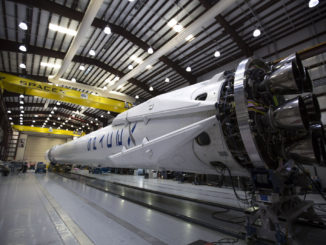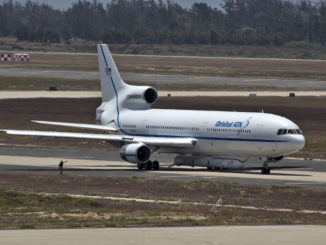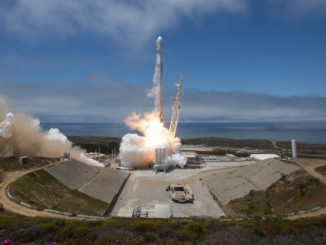Coverage begins at 11 a.m. EDT (1500 GMT).
The largest solid rocket booster in the world, an extended version of the space shuttle motor, will be test-fired in Utah on Wednesday to check its qualifications to be part of NASA’s new heavy-lift Space Launch System.
Comprised mostly of legacy space shuttle parts, including a piece from the final mission in 2011, the booster is strapped down horizontally at Orbital ATK’s T-97 test stand in Promontory, Utah.
Qualification Motor-1 (QM-1), fires to life at 11:30 a.m. EDT (9:30 a.m. local) for a 126-second, full-duration burn just like its intended to do during launch.
The ignition will send a rush of golden flame down the length of the booster and exited its nozzle at Mach 3 with a temperature of about 4,500 degrees F, hot enough to turn sand around the test site into glass.
The cylindrical booster, which is built up in segments, adds a fifth section over the four-segment shuttle boosters that flew for 30 years. The ongoing test program is aimed at verifying the design of the larger motor system in preparation for inclusion on the first SLS launch in 2018.
Wednesday’s test motor heritage includes segments from 23 shuttle flights, 10 ground tests and three all-new sections.
The motor produces a maximum thrust of 3.6 million pounds, or 22 million horsepower, an increase from the 3.3 million pounds of thrust generated by a shuttle booster.
“Years of extensive work and testing have gone into preparing us for this qualification test,” said Alex Priskos, manager of the SLS Boosters Office at Marshall. “We can’t stress enough what a big deal this is in preparing the rocket for flight.”
Housed in a heated, moveable covering structure, the solid-fuel propellant has been warmed to reach a mean bulk temperature of 90 degrees F, despite the conditions outside. This test booster, dubbed a “hot motor,” is designed to qualify it at the high end of accepted temperatures and demonstrate the motor meets ballistic requirements.
The rubber-like fuel resembling a pencil eraser is a blend of aluminum powder, ammonium perchlorate, HB polymer, iron oxide and an epoxy curing. The casings were cast with the fuel and then mated together on the test stand in preparation for Wednesday’s firing.
Some 534 instrumentation channels will be used to help evaluate 103 design objectives. Upcoming, an extensive post-fire disassembly will be conducted to allow engineers to inspect and analyze the booster.
A second SLS qualification test-firing is planned for early 2016. It continues engineering firings of the five-segment motor that has been underway for a few years.
There were 52 such firings performed for the space shuttle, dating back to July 1977 during the program’s early development. The last shuttle program test was conducted in February 2010.
SLS will employ two of the five-segment boosters for added thrust off the launch pad at Kennedy Space Center. The boosters will be strapped to the main stage that is powered by four former space shuttle main engines. The solids generate 75 percent of the lift needed to escape the Earth during the first two minutes of flight.
“We don’t need to recover the boosters because we have saved enough booster hardware to advance them for SLS specifications, resulting in cost savings,” said Bruce Tiller, deputy manager of the SLS Boosters Office at Marshall. “Removing all the parachutes and their associated infrastructure lifts many thousands of pounds off the vehicle and improves performance to carry more payload.”
After manufacture in Utah, the booster segments are transported by railroad to the Kennedy Space Center in Florida. Stacking will occur in the Vehicle Assembly Building like the space shuttle boosters.
The first flight of the SLS will have a 77-ton lift capacity and carry an uncrewed Orion spacecraft beyond low-Earth orbit.
Twin solid rocket boosters were introduced to human spaceflight on the first launch of the space shuttle in 1981. Some 270 motors flew over the 30-year course of the shuttle program.



